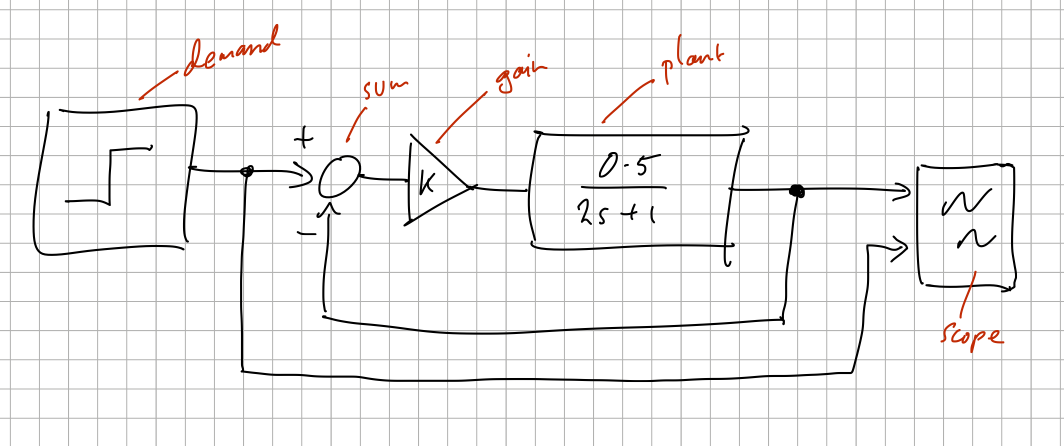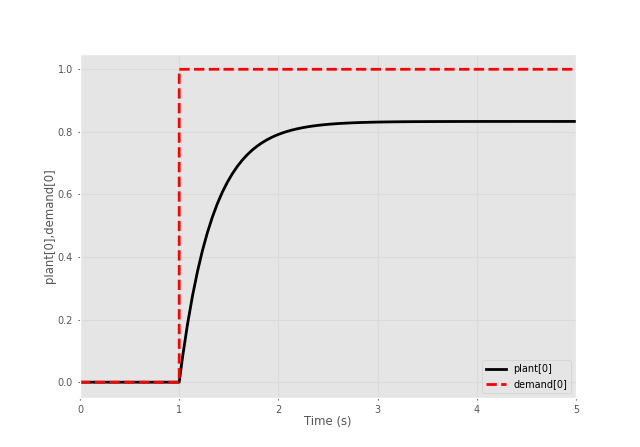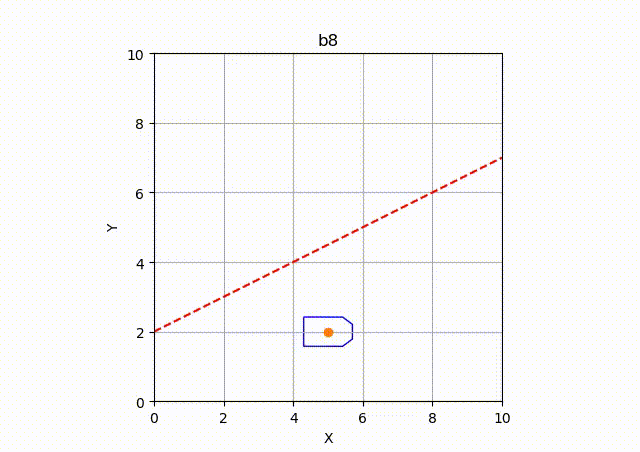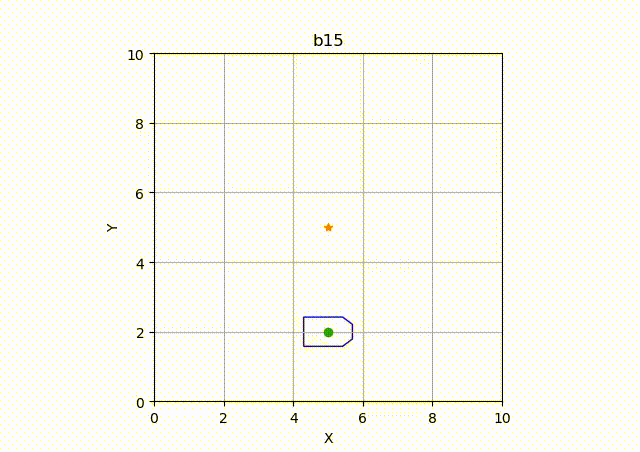Simulate dynamic systems expressed in block diagram form using Python.
Project description
- GitHub repository: https://github.com/petercorke/bdsim
- Examples and details: https://github.com/petercorke/bdsim/wiki
- Documentation: https://petercorke.github.io/bdsim
- Dependencies:
numpy,scipy,matplotlib,spatialmath,ffmpeg(if rendering animations as a movie)
Block diagram simulation
This Python package enables modelling and simulation of dynamic systems conceptualized in block diagram form, but represented in terms of Python class and method calls. Unlike Simulink or LabView we write Python code rather than drawing boxes and wires. Wires can communicate any Python type such as scalars, lists, numpy arrays, other objects, and even functions.
We first sketch the dynamic system we want to simulate as a block diagram, for example this simple first-order system
which we can express concisely with bdsim as (see bdsim/examples/eg1.py
1 #!/usr/bin/env python3
2
3 import bdsim.simulation as sim
4
5 bd = sim.Simulation()
6
7 # define the blocks
8 demand = bd.STEP(T=1, pos=(0,0), name='demand')
9 sum = bd.SUM('+-', pos=(1,0))
10 gain = bd.GAIN(10, pos=(1.5,0))
11 plant = bd.LTI_SISO(0.5, [2, 1], name='plant', pos=(3,0))
12 scope = bd.SCOPE(styles=['k', 'r--'], pos=(4,0))
13
14 # connect the blocks
15 bd.connect(demand, sum[0], scope[1])
16 bd.connect(plant, sum[1])
17 bd.connect(sum, gain)
18 bd.connect(gain, plant)
19 bd.connect(plant, scope[0])
20
21 bd.compile() # check the diagram
22 bd.report() # list all blocks and wires
23
24 bd.run(5) # simulate for 5s
25
26 bd.dotfile('bd1.dot') # output a graphviz dot file
27 bd.savefig('pdf') # save all figures as pdf
28
29 bd.done()
which is just 18 lines of code.
The red block annotations in the diagram are the names of blocks, and have become names of instances of object that represent those blocks. The blocks can also have names which are used in diagnostics and as labels in plots.
In bdsim all wires are point to point, a one-to-many connection is implemented by many wires.
Ports are designated using Python indexing and slicing notation, for example sum[0]. Whether it is an input or output port depends on context. Blocks are connected by connect(from, to_1, to_2, ...) so an index on the first argument refers to an output port, while on the second (or subsequent) arguments refers to an input port. If a port has only a single port then no index is required.
A bundle of wires can be denoted using slice notation, for example block[2:4] refers to ports 2 and 3. When connecting slices of ports the number of wires in each slice must be consistent. You could even do a cross over by connecting block1[2:4] to block2[5:2:-1].
Line 22 shows a report, in tabular form, showing all the blocks and wires in the diagram.
Blocks::
id name nin nout nstate
---- ------------------ ----- ------ --------
0 source.step.demand 0 1 0
1 function.sum.b1 2 1 0
2 function.gain.b2 1 1 0
3 transfer.LTI.plant 1 1 1
4 sink.scope.b4 2 0 0
Wires::
id from to description type
---- ------ ------ ------------------------------ -------
0 0[0] 1[0] step.demand[0] --> sum.b1[0] int
1 0[0] 4[1] step.demand[0] --> scope.b4[1] int
2 3[0] 1[1] LTI.plant[0] --> sum.b1[1] float64
3 1[0] 2[0] sum.b1[0] --> gain.b2[0] float64
4 2[0] 3[0] gain.b2[0] --> LTI.plant[0] float64
5 3[0] 4[0] LTI.plant[0] --> scope.b4[0] float64
Line 24 runs the simulation for 5 seconds
s.run(5)
using the default variable-step RK45 solver and saves output values at least every 0.1s. The scope block pops up a graph
Line 27 causes the graphs in all displayed figures to be saved in the specified format, in this case the file would be called scope.b4.pdf.
Line 28 blocks the script until all figure windows are closed, or the script is killed with SIGINT.
To save the results is achieved by
out = s.run(5, dt=0.1)
The result out is effectively a structure with elements
tthe time vector: ndarray, shape=(M,)xis the state vector: ndarray, shape=(M,N)xnamesis a list of the names of the states corresponding to columns ofx, eg. "plant.x0"
Line 26 attempts to produce something like a real block diagram by generating produce a Graphviz .dot file. Using dot
we can generate a graphic
% dot -Tpng -o demo.png demo.dot
or neato
% neato -Tpng -o demo.png demo.dot
While this is topologically correct, it's not quite the way we would expect the diagram to be drawn. dot ignores the pos options on the blocks while neato respects them, but is prone to drawing all the lines on top of each other.
Sources are shown as 3D boxes, sinks as folders, functions as boxes (apart from gains which are triangles and summing junctions which are points), and transfer functions as connectors (look's like a gate). To create a decent looking plot you need to manually place the blocks using the pos argument to place them. Unit spacing in the x- and y-directions is generally sufficient.
Other examples
In the folder bdsim/examples you can find a couple of runnable examples:
eg1.pythe example given abovewaveform.pytwo signal generators connected to two scopes
Examples from Chapter four of Robotics, Vision & Control (2017):
rvc4_2.pyFig 4.2 - a car-like vehicle with bicycle kinematics driven by a rectangular pulse steering signalrvc4_4.pyFig 4.4 - a car-like vehicle driving to a point
rvc4_6.pyFig 4.6 - a car-like vehicle driving to/along a line
rvc4_11.pyFig 4.11 a car-like vehicle driving to a pose
Figs 4.8 (pure pursuit) and Fig 4.21 (quadrotor control) are yet to be done.
Limitations
There are lots! The biggest is that bdsim is based on a very standard variable-step integrator from the scipy library. For discontinuous inputs (step, square wave, triangle wave, piecewise constant) the transitions get missed. This also makes it inaccurate to simulate hybrid discrete-continuous time systems. We really need a better integrator.
Project details
Release history Release notifications | RSS feed
Download files
Download the file for your platform. If you're not sure which to choose, learn more about installing packages.






















